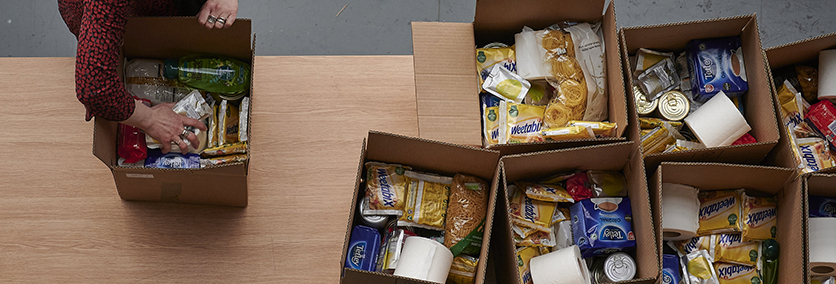Food Insecurity

Overview
Featured Expert(s)
Diane Whitmore Schanzenbach

IPR Director Diane Whitmore Schanzenbach is an economist who studies policies aimed at improving the lives of children in poverty, including education, health, and income support policies. Her recent work has focused on tracing the impact of major public policies such as the Food Stamp Program and early childhood education on children’s long-term outcomes.
Research Roundup
The Impact of SNAP Emergency Allotments on SNAP Benefits and Food Insufficiency
January 2023
Since April 2020, states have been able to award Emergency Allotment, or EA, payments to SNAP recipients to supplement the formula-based SNAP benefits that they otherwise would have received. Nationwide, EA payments will be eliminated after the February 2023 payment, and SNAP benefits will revert for each family to the value that the SNAP benefit formula allocates. This rapid research report by IPR Director and economist Diane Whitmore Schanzenbach estimates the amount and impact of EA benefits.
The Link Between Water and Food Insecurity
July 2022
In a new study, IPR researchers show that avoiding tap water can increase an individual's chances of experiencing food insecurity. Asher Rosinger of Penn State University, IPR research associate Hilary Bethancourt, and IPR anthropologist Sera Young find that avoiding tap water is associated with a 20% to 30% increased likelihood of experiencing food insecurity in the United States.
App Explores Seven Key Economic Indicators
December 2020
IPR researchers have created a new application for tracking seven economic indicators data across the nation and state by state. Users can find data from April 23 onward from the U.S. Census Bureau Household Pulse Survey on unemployment, children's schooling, housing, finances, mental health, and food insecurity for American households. Read the summary or the accompanying report.
Visualizing Food Insecurity
July 2020
IPR researchers have created a new tool for visualizing food insecurity data across the nation. Users can find data from April 23 onward from the U.S. Census Bureau Household Pulse Survey on weekly rates of food insecurity for respondents with and without children, which can also be sorted by race and ethnicity for selected states. The complete report can be read here.
Racial Disparities in Food Insecurity Persist
July 2020
In another report based on Census Household Pulse Survey data, IPR director and economist Diane Whitmore Schanzenbach and research analyst Abigail Pitts look at recent trends in food insecurity in the wake of the COVID-19 pandemic. They find that food insecurity rates and related measures of food hardship are elevated for all groups, and there is some evidence they have improved in recent weeks among White households. Overall, Black and Hispanic households with children are much more likely to experience food hardships than are White households with children.
Food Insecurity Remains Elevated Across All 50 States
June 2020
In a report, Schanzenbach and Pitts estimate current rates of food insecurity and the extent to which food insecurity rates have increased in national data, as well as by state. They find that food insecurity has doubled overall, and tripled among households with children, and that twenty-three percent of households overall experienced food insecurity in the first 3 waves of the Census’s Household Pulse Survey (CHHPS), which was collected from April 23–May 19.
Food Insecurity in the Census Household Pulse Survey Data Tables
June 2020
In a report, Schanzenbach and Pitts estimate rates of food insecurity from the Census Household Pulse Survey (CHHPS) that, depending on the approach taken to map food insufficiency onto food insecurity, range in the first week of data collection from 23%–31% for respondents overall and 28%–37% among respondents with children. The estimates of food insecurity from the CHHPS are very similar to those found in the COVID Impact Survey (COVID Impact) and indicate that food insecurity rates have at least doubled from their previous levels.
Food Insecurity Remains at Persistently High Levels in May
May 2020
This report from IPR economist Diane Whitmore Schanzenbach and research analyst Abigail Pitts shows that food insecurity remained persistently high in May. Their previous report from earlier in May revealed that food insecurity tripled for families with children during the COVID-19 pandemic. Using data from the COVID Impact Survey, they find that nearly half of those surveyed with children said they were worried about food running out before they had money to buy more. The state of Louisiana had the highest estimated rate of food insecurity, with more than 1 in 3 respondents reporting being food insecure, and it was highest in the Birmingham, Columbus (Ohio), Chicago, and Phoenix metro areas.
Food Insecurity Triples for Families with Children During COVID-19 Pandemic
May 2020
New evidence is emerging from surveys since the COVID-19 pandemic began that document dramatic increases in food insecurity as well as very low food security—a more severe condition in which there have been substantial disruptions or reductions in food intake—among adults, children, and other vulnerable populations. In their first full report and appendix, IPR Director and economist Diane Whitmore Schanzenbach and research analyst Abigail Pitts take several approaches to contextualizing current levels of food insecurity in the United States, using data from the COVID Impact Survey.
The Changing Safety Net for Children
December 2018
A new rule by the current White House administration has tighten regulations for those who receive food stamps and work, which could cut benefits for tens of thousands of people. IPR economist Diane Whitmore Schanzenbach finds that 80% of safety net spending has shifted to households with earnings—where people work—than to the poorest households without earnings. She notes that moving to work-contingent assistance is problematic for people in these households who rely on SNAP benefits.
SNAP’s Short- and Long-Term Benefits
January 2017
The Supplemental Nutrition Assistance Program (SNAP), formerly known as the Food Stamp Program, is the fundamental safety net for American families, lifting 5 million people out of poverty in 2014 (the most recent data available). With more and more families receiving benefits from programs like SNAP, IPR economist Diane Whitmore Schanzenbach is examining the program’s short- and long-term effects. She finds that SNAP improves birth outcomes and long-term health for recipients, and leads to better economic outcomes for women